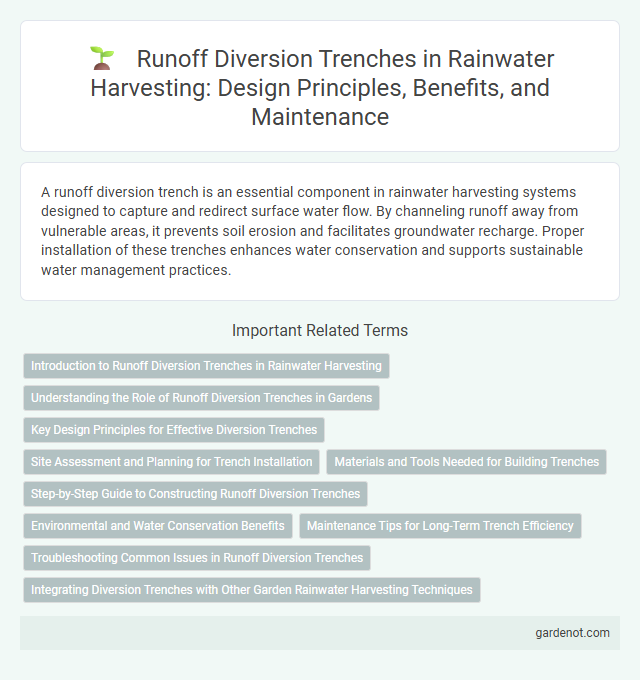A runoff diversion trench is an essential component in rainwater harvesting systems designed to capture and redirect surface water flow. By channeling runoff away from vulnerable areas, it prevents soil erosion and facilitates groundwater recharge. Proper installation of these trenches enhances water conservation and supports sustainable water management practices.
Introduction to Runoff Diversion Trenches in Rainwater Harvesting
Runoff diversion trenches play a crucial role in rainwater harvesting by channeling excess surface runoff into designated storage or infiltration areas, preventing soil erosion and reducing flood risks. These trenches are strategically designed to intercept and slow down rainwater flow, enhancing groundwater recharge and conserving moisture in arid and semi-arid regions. Implementing runoff diversion trenches contributes to sustainable water management by maximizing rainwater utilization and maintaining landscape stability.
Understanding the Role of Runoff Diversion Trenches in Gardens
Runoff diversion trenches play a crucial role in rainwater harvesting by redirecting excess surface water away from garden areas, preventing soil erosion and waterlogging. These trenches help in enhancing groundwater recharge by channeling runoff into permeable areas, promoting healthier plant growth and conserving water resources. Properly designed runoff diversion trenches optimize water management in gardens, supporting sustainable landscape practices.
Key Design Principles for Effective Diversion Trenches
A runoff diversion trench must be designed with proper slope, typically between 1-3%, to ensure efficient water flow without causing erosion. The trench dimensions should accommodate peak runoff volumes, considering local rainfall intensity and catchment area size. Durable materials and stable side slopes prevent collapse, while periodic maintenance ensures functionality and sediment clearance.
Site Assessment and Planning for Trench Installation
Site assessment for runoff diversion trench installation involves analyzing soil type, slope gradient, and drainage patterns to ensure optimal water flow and trench stability. Planning includes selecting a location away from structures to prevent foundation damage while maximizing water capture and minimizing erosion. Accurate measurements and mapping of the catchment area support efficient design and maintenance of the trench system.
Materials and Tools Needed for Building Trenches
Constructing runoff diversion trenches requires essential materials such as durable landscape fabric to prevent soil erosion, gravel or crushed stone for effective drainage, and sturdy wooden or metal stakes to support trench walls. Tools necessary for this project include shovels for excavation, measuring tapes for precise trench dimensions, and wheelbarrows for transporting soil and materials. Proper selection and use of these materials and tools ensure efficient water diversion and long-term trench stability.
Step-by-Step Guide to Constructing Runoff Diversion Trenches
To construct a runoff diversion trench, begin by selecting a suitable location along the slope where water flow is concentrated. Excavate a trench 30-60 cm deep and 45-90 cm wide, ensuring a slight gradient to direct water away from vulnerable areas. Line the trench with gravel or stones to enhance infiltration and prevent soil erosion, then cover it with mulch or vegetation for added stability and water absorption.
Environmental and Water Conservation Benefits
A runoff diversion trench effectively reduces soil erosion by channeling excess rainwater away from vulnerable land, promoting groundwater recharge and maintaining soil fertility. This method conserves water by capturing and directing runoff to storage areas or infiltration sites, minimizing water loss and enhancing water availability during dry periods. By managing stormwater sustainably, runoff diversion trenches protect ecosystems and support biodiversity through improved habitat conditions.
Maintenance Tips for Long-Term Trench Efficiency
Regularly removing debris and sediment from the runoff diversion trench prevents blockages that reduce water flow efficiency. Inspecting trench linings and repairing cracks or erosion ensures structural integrity and optimal runoff channeling. Periodic vegetation management around the trench minimizes root intrusion and sediment buildup, supporting sustained long-term performance.
Troubleshooting Common Issues in Runoff Diversion Trenches
Runoff diversion trenches often face clogging due to sediment accumulation, which reduces water flow efficiency and can cause overflow problems. Regular inspection and removal of debris, combined with installing sediment traps upstream, help maintain optimal trench performance. Structural damage like trench collapse or erosion can be mitigated by reinforcing trench walls with geotextile fabrics and ensuring proper slope grading to prevent soil displacement.
Integrating Diversion Trenches with Other Garden Rainwater Harvesting Techniques
Integrating runoff diversion trenches with rain gardens and bioswales enhances water infiltration by directing excess flow into vegetated areas, reducing soil erosion and increasing groundwater recharge. Combining trenches with permeable pavements and contour trenches further optimizes rainwater capture, promoting sustainable stormwater management in garden landscapes. Strategic placement of diversion trenches alongside rain barrels can also improve water collection efficiency, supporting plant irrigation during dry periods.
Runoff diversion trench Infographic

 gardenot.com
gardenot.com